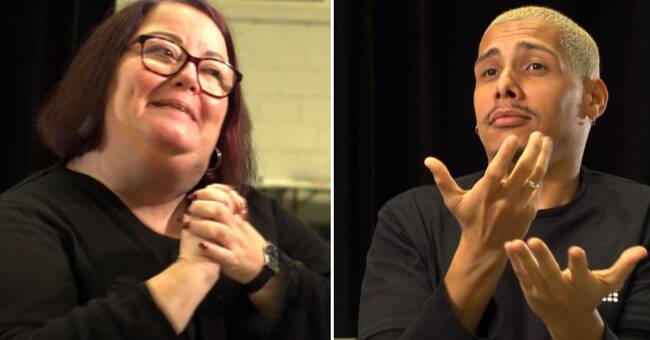- I love sign language poetry and love how the two art forms can meet, says VV artist Gustavo Gusmão from Brazil.
The participants came from Germany, Great Britain and Brazil, among others, all with their own national sign languages.
For three days, they gathered to explore with their Swedish colleagues the possibilities for the sign language art forms.
With this initiative, the Riksteatern hopes to contribute to the development of these unique art genres.
"We thought the same"
The participants were divided into two different groups and then paired around a specific task.
- They got a picture of a man with a cross on.
A person who works with visual vernacular and one who works with sign language poetry - and even though they did not use any words at all, they told the same thing, says course leader Giuseppe Giuranna when Kulturnyheterna visits in Hallunda ..
- We also thought it was a grave.
The person was sitting by a cross, thinking of his family, people who had passed away.
But then there was a difference in how we worked technically with sign language, says Juli af Klintberg.
This is how the art form works
Plumbing expert Guianna explains how the art form works.
There is a lot of tempo change and facial expressions, unlike the emotion-driven sign language poetry.
But for the unaccustomed viewer, the difference may not always be so clear.
Specific to visual vernacular, however, is that the artist or performer can take perspective of an object such as a microphone or a glass you drink from.
The importance of social media
The actor Juli af Klintberg, who started with sign language poetry 30 years ago, believes that social media has meant a lot to the development of sign language art.
Practitioners find it much easier to show their work to each other and let themselves be inspired by what happens beyond their own geographical and linguistic barriers.
- But it's still a bit if you look around the world.
So we'm pretty hungry for an exchange like this.
- It is a fantastic chance to meet and work together.
We are from a lot of different countries so we use international characters.
It is high ceilings when we discuss.
Gustavo Gusmão agrees.
- I myself work as a teacher and teach visual vernacular.
I am also an actor, so to come to Sweden, meet others and to be part of this exchange, it fills with energy so when I go back to Brazil I can pass on to others, he says.

